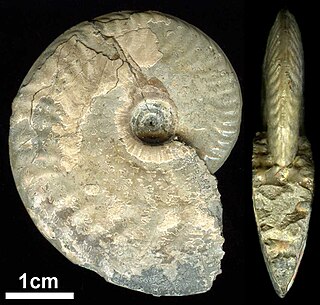Related Research Articles

The Aalenian is a subdivision of the Middle Jurassic Epoch/Series of the geologic timescale that extends from about 174.1 Ma to about 170.3 Ma. It was preceded by the Toarcian and succeeded by the Bajocian.
In the geologic timescale, the Bajocian is an age and stage in the Middle Jurassic. It lasted from approximately 170.3 Ma to around 168.3 Ma. The Bajocian Age succeeds the Aalenian Age and precedes the Bathonian Age.

Stephanoceras is an extinct genus of Stephanoceratoid ammonite which lived during the Bajocian. It is the type genus of the family Stephanoceratidae.
Abbasites is an extinct genus of ammonites from the early Middle Jurassic epoch, included in the ammonitid family Erycitidae.

Ammonitina comprises a diverse suborder of ammonite cephalopods that lived during the Jurassic and Cretaceous periods of the Mesozoic Era. They are excellent index fossils, and it is often possible to link the rock layer in which they are found to specific geological time periods.
Ermoceras is a genus of ammonite belonging to the Thomboceratidae family of the Middle Jurassic found in deposites of central Arabia, Sinai, and Algeria with strong primary and secondary ribs and a single row of lateral tubercles; described as having a deep ventral groove
Emileia is an extinct genus from a well-known class of fossil cephalopods, the ammonites, that lived during the early part of the Bajocian.
Duashnoceras is an extinct ammonoid cephalopod genus included in the Stephanoceratidae that lived during the Bathonian stage of the Middle Jurassic.
Phaulostephanus is an extinct genus from the ammonoid family Stephanoceratidae, which is part of the ammonitid superfamily Stephanoceratoidea, that lived during the early Middle Jurassic.
Parastrenoceras is an extinct genus from the ammonoid cephalopod order Ammonitida, included in the family Spiroceratidae that lived during the Bajocian stage of the Middle Jurassic.
Lissoceras is an involute, smooth or finely vetrolaterally ribbed, ammonite with a blunt, un-keeled venter, included in the Haploceratidae, that lived from the Lower Bajocian - Middle Oxfordian in what is now Europe, south Asia, and southern Alaska.

Ophthalmosauridae is an extinct family of thunnosaur ichthyosaurs from the Middle Jurassic to the early Late Cretaceous worldwide. Almost all ichthyosaurs from the Middle Jurassic onwards belong to the family, until the extinction of ichthyosaurs in the early Late Cretaceous. Opthalmosaurids appeared worldwide during early Bajocian, subsequent to the disappearance of most other ichthyosaur lineages after the end of the Toarcian. Currently, the oldest known ophthalmosaurids is Mollesaurus from the early Bajocian of Argentina, as well as indeterminate remains of the same age from Luxembourg and Canada. Named by George H. Baur, in 1887, the family contains the basal taxa like Ophthalmosaurus. Appleby (1956) named the taxon Ophthalmosauria which was followed by some authors, but these two names are often treated as synonyms; Ophthalmosauridae has the priority over Ophthalmosauria. However, some researchers argue that Ophthalmosauridae should be restricted to the group typically referred to as Ophthalmosaurinae, with classic Platypterygiinae instead being referred to as Undorosauridae or Brachypterygiidae and Ophthalmosauria being used to unite these two groups.
Otoidtidae: stephanoceratoid ammonitina from the early Middle Jurassic that begin as cadicones but become more planualte with age; derived from the Hammitoceratidae (Hildoceratoidea), probably through Erycites by way of Abbasites.
Subcollina is a genus of evolute to serpenticonic stephanoceratacean ammonites from the Middle Jurassic (Baj) of Mexico, placed in the family Spiroceratidae.

Perisphinctoidea, formerly Perisphinctaceae, is a superfamily of Middle Jurassic (Bajocian) to Lower Cretaceous (Barremian) ammonites, commonly with evolute shells with strong ribbing that typically divides about mid flank before crossing the venter.

Oppeliidae are compressed to oxyconic, sculptured Haploceratoidea, either unkeeled, unicarinate, bicarinate, or tricarinate; with sutures in great variety, but ribbing usually more or less falcoid or falcate. The Oppeliidae is the principal family of the Haploceratoidea, with the longest duration, extending from the Middle Jurassic (Bajocian) to the Upper Cretaceous (Cenomanian) Their derivation is from the Hildoceratoidea.

Hildoceratidae is a family of ammonoid cephalopods from the Lower Jurassic, lower Pliensbachian to lower Bajocian substages, generally with strongly ribbed, involute shells. They are combined with the Hammatoceratidae, Graphoceratidae, and Sonniniidae to make up the Hildoceratoidea.

Calliphylloceras is an ammonite belonging to the Phylloceratidae.

Skirroceras macrum is a Stephanoceratacean (ammonite) species belonging to the family Stephanoceratidae.

Hammatoceratidae is a family of lower and middle Jurassic ammonites included in the superfamily Hildoceratoidea.